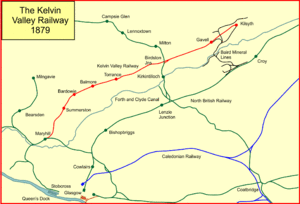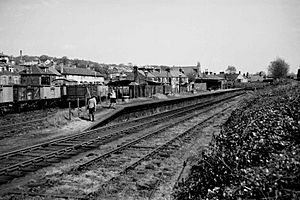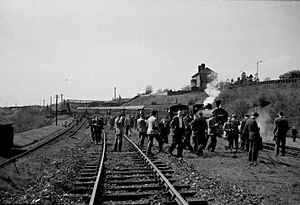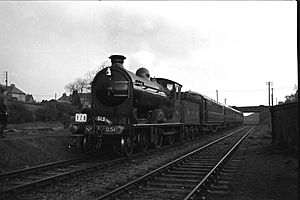Kelvin Valley Railway facts for kids
Quick facts for kids Kelvin Valley Railway |
|
|---|---|
| Overview | |
| Locale | Scotland |
| History | |
| Opened | 1878 |
| Successor line | North British Railway |
| Closed | 1951 |
| Technical | |
| Line length | 11+1⁄2 miles (18.5 km) |
| Track gauge | 4 ft 8 1⁄2 in (1,435 mm) |
The Kelvin Valley Railway was a special train line in central Scotland. It was built to link Kilsyth, a town known for mining, to the main railway system. The line opened in 1878. It helped transport coal from Kilsyth to the River Clyde. People also hoped it would carry many passengers. However, not many people used the train for travel. Buses became more popular, so passenger services stopped in 1951. The amount of coal being moved also decreased. The entire railway closed down in 1966. Today, no trains run on this old line.
Contents
History of the Kelvin Valley Railway
Why the Railway Was Needed
Kilsyth was a busy place with many quarries and mines. It also had factories that made chemicals and coke. Iron ore was very important here. A company called Baird Brothers, led by James Baird, controlled most of the iron mining. This ore became more valuable as other mines ran out.
Kilsyth was near the Forth and Clyde Canal. The Baird company had built many small train lines, called mineral tramways, to connect their mines to the canal. But in the age of bigger railways, being far from the main lines was a problem.
Local business people decided to build a new railway. This railway would help move minerals to Coatbridge and Maryhill. Coatbridge was a big center for making iron. The new line would connect to the Campsie Branch of the North British Railway near Birdston. From there, trains could go to the Monkland and Kirkintilloch Railway.
Maryhill offered a way to reach the River Clyde. A new line, the Stobcross Railway, was being built to serve the Queen's Dock in Glasgow. This dock would allow goods to be shipped by sea. The railway's builders also hoped that fancy houses would be built along the line. This would mean more people would travel by train to work in Glasgow.
Plans for the New Railway
In 1873, a plan for the Kelvin Valley Railway was shared. Many local people supported it. The North British Railway (NBR) agreed to operate the line. However, the NBR was not very excited about the railway's future. They only agreed to keep their rival, the Caledonian Railway, from building in the area.
The Kelvin Valley Railway company was officially created by a special law on July 21, 1873. This law allowed them to build a line from Kilsyth to Maryhill. It also included a short connection to the Campsie branch at Birdston. The company was allowed to raise £90,000 to build the line.
The company struggled to get enough money to build the railway. This was partly because the NBR was not very keen. The Baird Brothers company already had many small train lines around Kilsyth. They used their power to get what they wanted. They threatened to build a railway going east from Kilsyth to connect with the Caledonian Railway. This would have meant a longer trip for their minerals to Glasgow. But for the NBR, it meant losing all that business to a competitor.
So, the NBR decided to propose their own "Kilsyth Railway." This line would run from Kilsyth to Birdston. It would connect to the Campsie branch, giving access to both Coatbridge and Glasgow. The NBR also planned an eastern line to Falkirk. This was clearly to stop the Caledonian Railway from expanding further. The Kilsyth Railway was approved by law on July 13, 1876.
After getting approval for this railway, the NBR made a deal with the Baird Brothers and the Kelvin Valley promoters. They agreed to build the Kelvin Valley line mostly as first planned. They only changed the route near Kilsyth to use the Kilsyth Railway's path. This suited the Baird Brothers better. This agreement was approved by Parliament on May 17, 1877. The Kilsyth Railway company was then closed down. The NBR invested £30,000 in the Kelvin Valley line. They also agreed to operate the line for half of the money it earned. They promised a 5.25% profit on the money invested.
Opening the Railway
The North British Railway saw that Kilsyth was the most important place on the line for business. They built the section from Kilsyth to Birdston first. This part opened on June 1, 1878. It allowed minerals from Kilsyth to reach the new Queen's Dock on the Clyde. Passengers could also travel to Glasgow.
The NBR seemed to be in charge of the whole project. They were not eager to build the western part of the line, from Birdston to Maryhill. Opening it would mean less business for their own existing lines. However, the Kelvin Valley company, mainly the Baird Brothers, pushed them to build it. This section opened for goods on June 4, 1879. The connection at Maryhill was not finished yet. Also, the passenger stations and goods areas were not ready. The NBR was clearly doing only what they had to do.
At a meeting on September 25, 1879, some problems came out. The NBR had invested £66,000 in the Kelvin Valley line. But their shareholders had only approved £30,000. Also, some NBR directors had been illegally buying and selling Kelvin Valley shares. They lost £1,400 and were paid back with NBR money.
The Maryhill connection was finally made on October 1, 1879. But passenger trains to Kilsyth still went through Kirkintilloch. Only one train each way ran between Maryhill and a small stop called Torrance. The section from Torrance to Birdston had no passenger service. The Kelvin Valley Railway directors complained again. So, the NBR extended the Maryhill to Torrance train to Kilsyth from October 29, 1880. But this did not bring much extra money. So, the NBR stopped the extended journey on December 31, 1880.
The Railway Joins the NBR
The Kelvin Valley Railway was taken over by the North British Railway on August 1, 1885. The cost of building the line was £77,308. Kelvin Valley shareholders were promised a 4% profit for two years, then 5% forever.
The NBR opened the Glasgow City and District Railway in 1886. This new line went through Glasgow underground from east to west. It greatly helped reduce crowding at the Queen Street station. The NBR could now run more passenger trains on the Maryhill line. From 1886, trains usually started at Bridgeton Cross. They went through Queen Street Low Level and Maryhill, then to Torrance and Kilsyth. The old passenger service through Lenzie and Kirkintilloch also continued. However, not many people used these passenger services. The new houses that were hoped for were never built. Sunday school trips to the countryside were the busiest times for the line.
The Baird company's own small train lines connected to the Kelvin Valley line at Kilsyth. They also connected to the old Edinburgh and Glasgow Railway main line. But the company sent most of its minerals over the Kelvin Valley line to the docks on the Clyde. This became the main way the railway earned money.
On July 2, 1888, the Kilsyth and Bonnybridge Railway opened. It ran east from the Kilsyth station on the Kelvin Valley line. It connected to the Caledonian Railway line at Larbert Junction.
The Twentieth Century and Closure
The North British Railway became part of a new, bigger company called the London and North Eastern Railway (LNER). This happened in 1923, after a law called the Railways Act 1921. By this time, buses and better roads were taking away many passengers and goods from the railway.
In 1948, all railways in Britain became owned by the government. The Kelvin Valley line became part of British Railways Scottish Region. The railway looked at train services that were losing a lot of money. The Kelvin Valley line was one of them. Passenger services from Maryhill to Kilsyth stopped on March 31, 1951. Trains from Kirkintilloch to Kilsyth stopped on August 4, 1951.
The line stayed open for goods for a while. In 1958, new diesel trains were tested on the line.
In 1960, a special train tour for railway fans ran on the line. It was pulled by an old steam engine called Glen Douglas. This engine is now in the Riverside Museum in Glasgow. In 1966, goods trains stopped running. The Kelvin Valley Railway closed completely.
Route and Stations
The railway opened in two main parts. The section between Birdston Junction and Kilsyth opened on June 1, 1878. The section between Maryhill and Birdston Junction opened later, on October 1, 1879.
Here are the main places and stations along the route:
- Maryhill East Junction: This is where the Kelvin Valley line left the North British Railway line that went to Helensburgh.
- Summerston: This station closed on April 2, 1951.
- Bardowie: This station opened on June 1, 1905, and closed on July 20, 1931.
- Balmore: This station opened in April 1886 and closed on April 2, 1951.
- Torrance: This station closed on April 2, 1951.
- Kelvin Valley East Junction: This is where a connecting line from Birdston Junction joined the main line.
- Gavell: This station opened in December 1878. It was renamed Twechar in 1924 and closed on August 6, 1951.
- Kilsyth: This station was sometimes called Kilsyth Old or Kilsyth Junction. The Kilsyth and Bonnybridge Railway connected here from 1888. This station closed on August 6, 1951.





